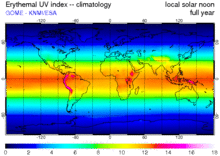
The ultraviolet index, or UV index, is an international standard measurement of the strength of the sunburn-producing ultraviolet (UV) radiation at a particular place and time. It is primarily used in daily and hourly forecasts aimed at the general public. The UV index is designed as an open-ended linear scale, directly proportional to the intensity of UV radiation, and adjusting for wavelength based on what causes human skin to sunburn.[1] The purpose of the UV index is to help people effectively protect themselves from UV radiation, which has health benefits in moderation but in excess causes sunburn, skin aging, DNA damage, skin cancer, immunosuppression,[2] and eye damage, such as cataracts.
The scale was developed by Canadian scientists in 1992, and then adopted and standardized by the UN's World Health Organization and World Meteorological Organization in 1994.[3] Public health organizations recommend that people protect themselves (for example, by applying sunscreen to the skin and wearing a hat and sunglasses) if they spend substantial time outdoors when the UV index is 3 or higher; see the table below for more detailed recommendations.
- ^ "UV Index Overview". U.S. Environmental Protection Agency. 2022.
- ^ Hanneman, K. K.; et al. (January 2006). "Ultraviolet immunosuppression: Mechanisms and consequences". Dermatologic Clinics. 24 (1): 19–25. doi:10.1016/j.det.2005.08.003. PMID 16311164.
- ^ Heckman, C. J.; Liang, K.; Riley, M. (2022). "Awareness, Understanding, Use, and Impact of the UV Index: A Systematic Review of Over Two Decades of International Research". Preventive Medicine. 123: 71–83. doi:10.1016/j.ypmed.2019.03.004. PMC 6534479. PMID 30844501.